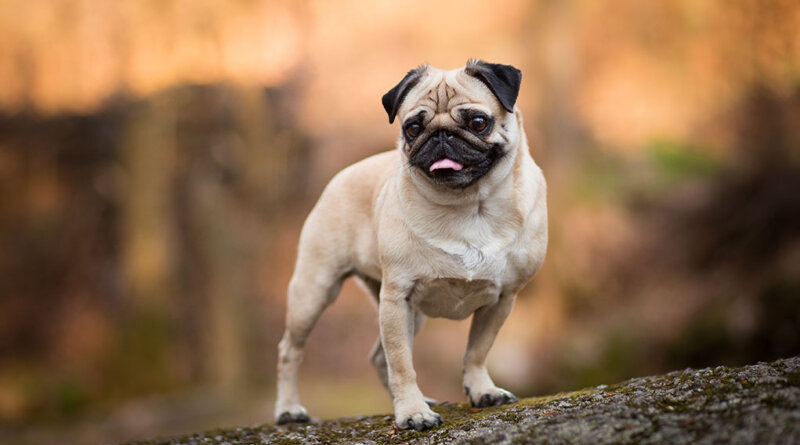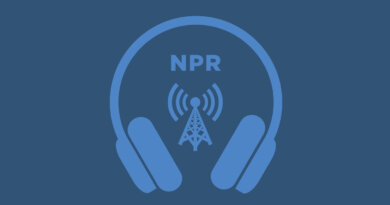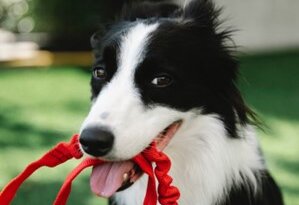Pug Dog Breed Profile – Top Dog Tips
Is that a dog or a cartoon? That’s a Pug!
That’s right, that dog that has big round eyes, floppy ears, a small but sturdy body, and a curved tail is an actual dog.
Pugs don’t only have the visual of a cartoon character, their personality is one as well.
Pugs are well known almost everywhere, their popularity skyrocketed not just in China but worldwide.
With their humorous demeanor and comical features, Pugs have become widely known as great family dogs. They go along extremely well with their owners, family, and even children.
Although Pug puppies are quite a unit, they’re part of the Toy category. Their small structure is perfect for lap dogs as they were intended made.
Pugs can have 3 to 5 litter normally. A group of Pugs is known as a ‘grumble’.
But before getting deep about this dog breed, let’s look back on the Pug history:
Pug History
The Pug’s wrinkly face trademark way bred to be that way by the Chinese. It was bred specifically to resemble the letters ‘王子’ which means ‘prince’ in Chinese.
Pug is known as an Ancient breed in China. They have lived among Buddhists, Emperors, and the Imperial Court.
Pugs were alongside Buddhist monks as pets in the Tibetan Buddhist monasteries.
Since the Emperors in China have a preference for flat-faced dogs, Pug became part of the Imperial household, breeding them into lapdogs. Thus, the Pugs up-to-date still do not need much exercise.
Pugs were so rare for they were only given to outsiders as a present from the Imperial Family.
Pugs were introduced outside of China around the 1500s. Their popularity crossed from China, and Japan to Europe.
As the Pug’s specimen was brought to Europe, the Oug’s popularity skyrocketed as an incident with the Prince of Orange occurred.
It is said the Pug present at the scene warned the Prince with continuous barking before the attack occurred.
From royal household to modern times, Pug has paved its way to humans as guard dogs to companion dogs.
With their boxy built and small structure, they became well known as one of the best companion dogs.
Physical Traits of the Pug Dog Breed
Pugs are squarish and compact in shape. They are roughly 10 – 13 inches tall weighing from 14-18 pounds. Pugs have a lifespan of 13- 17 years.
They have two standard coat colors: Black and Fawn. Some Pugs are nearly white by coat too.
Some Pugs have a black marking on the coat, usually in the ears and snout. Pug’s coats are soft, smooth, short, and glossy.
These dogs are bred to shape to be square and stocky, fit enough to be lapdogs.
Pugs have a large round head that looks proportionate to their body. Pugs have bulgy big round eyes which are usually dark in color.
The ears are thin but floppy that it drops down toward the front. Their forehead is prominently round with wrinkly skin as a trademark.
The mouth is mushed and is slightly undershot where the line falls as well.
Pug’s neck is slightly arched with adequate length, quite thick but connects to the body well. The chest is rather prominent and well ribbed.
Their stomach arches well toward the back. Pug’s forehead and hindquarters look straight and moderate in length. It is strong and parallel.
The Pug’s tail is supposedly curved twice and sits on its back. This was also a sign that they belonged to the toy dog category.
Temperament
Pugs are made to be family dogs. They do amazing with their owner, their family, and even children. Their small stature compliments their big personality.
Although Pugs were made to be guard dogs, they weren’t really up for the job.
Although they do bark at the presence of strange people, they’ll welcome them quite quickly once the owner shows it’s not dangerous.
Pugs are eager to please their humans and they enjoy getting a reaction from them as well.
They are a playful breed. Pugs don’t require extensive exercise regimens. Instead, owners can distribute play time as a part of their exercise.
Pugs are quite flexible with their owner’s lifestyle, as long as it’s not strenuous for them.
Whether it’s indoor or outdoor, it’s best to keep them cool and rested well after activities.
Pugs are companion dogs. They depend on the company of their owner or family.
It’s best not to leave Pugs alone for more than a couple of hours. If owners are to leave their homes, it’s best to have their Pugs left with someone they are also familiar with.
Leaving Pugs alone for a long period may cause depression and separation anxiety. Dog sit is the best option for owners.
Living with a Pug
Pugs are good with other dogs. They just need some gradual introduction so they don’t get all rowdy at the sudden changes in their environment.
But do observe their behavior when approaching other dogs. Some pugs get a bit jealous when their owners pay attention to other dogs.
It’s best to show that this other dog’s presence is something beneficial for them too. Giving them treats when the other dog is present is a start.
But other than that, Pugs get along well with other dogs. They are even better with cats but, of course, early socialization is the key.
Pugs should not be adopted unless they’re over three months old. Early socialization begins with their dam and litter.
After adopting, puppy training classes or early socialization and exposure should be done gradually.
Pugs don’t do well as guard dogs, so if owners are looking for one, Pugs are not the best choice.
Some Pugs are vocal and some are not. It depends on the environment and their altogether personality but Pugs are known to be not so much of a barker.
Pug Training & Exercise
Pugs are trainable but they have this attitude that they’d do things only when they want to. So it’s best to train them young firmly.
Not strictly but firmly, using positive reinforcement and the positive association works best with Pugs.
Pugs require moderate mental and physical needs and they also have moderate energy.
So they can have the training, exercise, and playtime distributed evenly daily. This can also help not make training feel like a routine for them.
Pugs need a moderate exercise regimen every day. They do not need extensive exercise daily.
Owners can spend their time with their Pugs at home but they should have them walked for at least 20 minutes a day. Do not over-exert Pugs in exercise.
Other exercise regimens can be distributed to playtime inside the home or maybe out in the yard.
Do keep in mind not to have your Pugs out when the weather is warm, as they are very intolerant of hot weather.
Pugs can be couch potatoes too. It’s important to get them their exercise needs for they are prone to become overweight.
Being overweight may lead to more diseases in the future, so keep the Pug getting their exercise needs at least for a few minutes a day.
Health of a Pug Dog
Pugs are a great breed that has a very long life span.
Pugs that are kept in great condition with updated check-ups and vaccination may live a healthy and long life.
Sadly, some Pugs are especially sensitive already, especially how their body is built.
Although there is no need for genetic testing required to breed Pugs, it is highly encouraged to breed Pugs that are regularly examined and up-to-date with their vaccination and annual needs to keep their health in shape.
Pugs may be healthy relatively but they are quite sensitive if exposed to a situation where in they may acquire this disease or disorder.
Here are some diseases or disorders to watch out for:
Coprophagia
Some Pugs have a tendency to eat their poop. Coprophagia is the behavior of dogs wherein they consume thein feces.
Although it’s a common behavior among canines, it can be dissuaded.
Coprophagia may depend on the cause it may vary from behavior, diet, or even medical causes.
It’s a dangerous habit for the dog and owner because it may cause infections from the unsanitary
Owners may check with their veterinarian if there are any medical, diet, or behavioral issues regarding their Pug. Yet one of the simplest solutions is promptly cleaning it after they defecate.
Another can be training them to leave the poop or avoid it together.
Degenerative Myelopathy / Nerve Degeneration
Degenerative Myelopathy is a disease that affects the spinal cord and results in weakness and paralysis.
Although the causes are yet to be known, Pugs who have degenerative myelopathy usually inherit it from their dam or sire.
It usually appears around 4 years old of age early to 10+ years latest.
Although there is no definite treatment, veterinarians usually address other conditions that come with it (such as hip dysplasia or arthritis).
Keeping the Pug’s health in great condition also helps prolong its life. It’s best to have the Pug tested if there are any suspected symptoms of degenerative myelopathy.
Eye Problems
Sadly, the Pug’s comical eyes have a lot of consequences. Of course, not all accidents can be prevented.
So it’s best to immediately have the Pug checked, better regularly, or immediately as needed.
Corneal Ulcers
Corneal ulcers are the condition of the outer layer of the eye breaking down causing a divot or dent. The condition may vary to a degree.
Usually, dogs are given anti-biotic and pain relievers as medication but sometimes veterinarians may need to inject it as needed to treat the ulcer more efficiently.
Entropion
Entropion is the condition where the eyelid rolls inward, creating fiction in the sensitive part of the cornea.
Usually, this condition requires surgery when it is quite damaging and may progress quicker than expected.
If Pugs are suspected to have entropion, owners should bring their Pugs to the veterinarian for further examination. Pugs have very sensitive eyes and may develop another disease if left as is.
Progressive Retinal Atrophy
Progressive Retinal Atrophy is a degenerative disease that affects the rod and cone cells in the eyes that leading to blindness. It is an inherited disease and it’s known for it has no treatment.
It can progress quickly from a year or two. Have your Pug checked regularly to guarantee less risk to their health.
Food Obsession – Pica
Some dogs, including Pugs, have the habit of wanting to eat all the time. Even after meals, they will find their way to get into food or anything they find edible.
Some dogs have their proopiomelanocortin (POMC) gene that modulates a dog’s appetite once it’s adequately mutated.
Instead of their brain signaling that the food they had intake is sufficient, it is nonfunctional.
Food obsession can develop behavioral and medical issues if not dealt with properly and immediately.
Owners can inquire with their veterinarian regarding this behavior. Veterinarians can provide solutions with supplements or tools that can help reduce food guzzling behavior.
Dog owners can also find ways so their Pugs do not guzzle on their food at home.
Owners can create a calmer environment during meal time for their Pugs or find ways to avoid food guzzling.
Hip Dysplasia
Hip dysplasia is a genetic condition wherein the socket of the joint and ball becomes distorted.
When diagnosed with hip dysplasia, it’s important to keep their weight in the normal range and have them exercise with activities that promote joint therapy.
Veterinarians may prescribe medications for anti-inflammatory/ pain relievers and supplements.
Prevention is the same, keeping them active but not injuring them as well. A treadmill walk or swimming is perfect for prevention and recovery as well.
Legg-Perthes Disease
Legg-Calve-Perthes Disease is a rare condition where the femoral head loses its blood supply resulting in inflammation or its destruction of the hip joint.
This disease is disabling and painful as well. It’s best addressed as soon as suspected.
Veterinarians may prescribe medications at first but will recommend procedures to reposition the femoral before any further damages.
Owners should deal with this condition immediately as it may progress quickly.
Patellar Luxation
Patella Luxation is the patella shifting alignment out of the femur. This can range from high to low levels of luxation, and each requires different treatments.
Symptoms may include skipping and kicking off the leg. It’s best to consult with the veterinarian for treatments, therapies, or procedures required to help Pugs with this condition.
Pug Dog Encephalitis
Pug Dog Encephalitis is a disease wherein there is inflammation of the brain that can lead to fatality. Although causes seem to be a genetic link, it has no known cure as of now.
It’s best to consult with the veterinarian for medication or procedures required to help Pugs with this condition.
Skin Problems (Atopic Dermatitis, Cheyletiella Dermatitis, Demodex Mange)
Atopic Dermatitis is the condition in which allergens in the surroundings, either inhaled or through contact, cause allergic reactions on the skin.
It may be difficult to determine what particularly stimulates the allergy but the effect in Pugs is usually found in the folds of their skin.
It’s important to address the allergy for it may lead to other infections if left as is.
Consulting with the veterinarian may help address the problem and determine what particularly triggered the allergic reaction.
Owners should have their Pug checked immediately if symptoms appear.
Cheyletiella Dermatitis is a skin condition caused by the Cheletiella mites. It is known as ‘walking dandruff.
It is a condition quite contagious in other animals too, from felines to rabbits.
Any symptoms suspected should be immediately reported to their veterinarians.
Owners should have their Pug deworming, tick, and flea prevention updated as they can help in prevention and protection.
Von Willebrand’s Disease
Von Willebrand Disease is a bleeding disorder in dogs and humans that is caused by a lack of protein in the blood.
The lack of protein disables clotting when there are open wounds and may result in great blood loss.
Some symptoms may be sustained bleeding after surgery or trauma.
Another is hemorrhage from various parts of the body, including the nose, oral mucous membrane, urinary bladder, and vagina.
Owners should check with their veterinarians for tests and further consulting regarding precautionary measures they have to take with Pugs who have the disease.
If the disease has taken place and is not addressed immediately, it may become fatal for the dog.
Pugs are Brachycephalic dogs. They have short noses and elongated palates that can cause breathing problems.
Pugs may have trouble breathing during warm weather. They may require surgery to broaden their nostrils.
If adopted from a reputable breeder, the Pugs will be less likely to have any health disorders.
If the owner ever plans to adopt from somewhere else, we highly recommend having it checked and tested with the veterinarian as soon as possible.
Diet of a Pug Dog Breed
Pugs are quite big eaters for their size. Although Pugs have a compact build, they have the appetite of a unit.
So it’s best to watch out for what they eat and how much as well.
Pugs can be given high-quality dry food or wet food, or a better mix in adequate amounts only.
About 1 cup of meal a day, divided into 2 or three, is a great way to serve their meal.
A lot of Pugs are food greedy, so owners can find ways to slow down their eating or stop food guzzling altogether with different instruments.
When training they can be motivated by the treats given. Owners should watch out how much they give as treats bought from stores may have large amounts of calories.
Pug Grooming
Pugs are known for their wrinkly look as well. Their wrinkly look has a short coat.
Pugs may have a short coat but they shed quite a lot. Brushing them at least twice a week can help with the shedding.
Brushing their coat may help distribute natural oils throat their body which is healthy for their skin as well. It’s also best to brush their shedding fur before it clutters around the home.
Pugs should be bathed at least twice to three times a month is good enough for their coat and skin.
Bath is especially needed after an activity that gets them grubby and grime. It’s good to wipe their paws after an outdoor activity too.
It’s best to have Pugs dried well after every bath, especially through every spot of the fold. These folds barely move on their own so grime and moisture may build up.
This build-up can cause hot spots or infections, so make sure to dry Pug’s well after the bath.
Remember to keep Pug’s ears dry after every bath. It’s best to clean it as well at least once a week.
Do not leave the ears moist as it may result in infection and may damage the inner ear canal.
Pugs should be nail trimmed at least once every two weeks. It’s best to keep their nails short as it may cause discomfort.
The nails aren’t necessarily needed to be trimmed. It can be filed instead as well, especially if it’s not that long.
Although Pugs have no problem with brushing, bathing, and trimming, it’s still best to introduce these activities during their young age.
Early exposure can make grooming routines effortless in the future.
Frequently Asked Questions About Pugs
Do Pugs bite?
Relatively Pugs are not biters. Their slight undershot keeps them from biting much.
Pugs are not known for being biters. They are quite playful and may pursue toys instead.
Do Pugs smell?
A Pug’s skin is wrinkly in shape, thus it creates folds that may bury parts of the skin if not moved regularly.
This fold may contain grime from activities or even skin problems if not checked regularly.
Pug needs to have grooming routines that can thoroughly check their skin, especially around the fold area, as it may build up hot spots or grimes that may result in infection or foul smells.
Do Pug’s eyes fall out?
Sadly yes, due to their facial structure and bulgy eye features, their eyes may bulge out of their eye socket.
When their facial muscles and neck have received a great amount of force, it can cause the eyes to pop out.
It’s best to use body collars instead so any pulling force will not heavily affect the muscles around the neck and face.
Pug Dog Breed Summary
Pugs are comedic companions and will set their way to make their owners happy.
If people are looking for a companion dog that is small in structure but big in personality, Pugs are the perfect candidate for you.
Pugs are amazing as family dogs and they will be around their family for a long time.
As long as they’re well taken care of, they will give back as much love and care as they are receiving.
Pug puppies are the best at making people laugh with their ridiculous antics and cheeky personality. They are great companions.
Owners can bring them along on their trips as long as it’s cool and maybe a bit chilly. Remember, Pugs are intolerable to heat.
Pugs may just be the perfect dog for you but remember as owers, we are responsible for taking care of them.
This includes providing for their daily needs, addressing any medical problem, and keeping their health fit and vaccinations up-to-date.
Remember to adopt Pugs from reputable breeders and not from puppy mills or irresponsible breeders.
Pugs with inherited diseases must not breed at all to avoid further Pugs with counts of diseases they may pass on.
RELATED: HAVANESE DOG BREED PROFILE
Related










